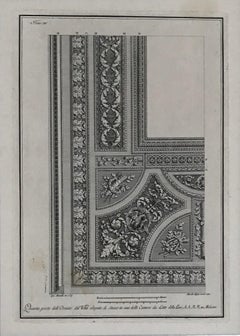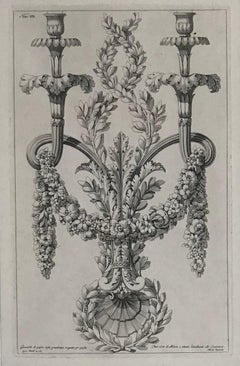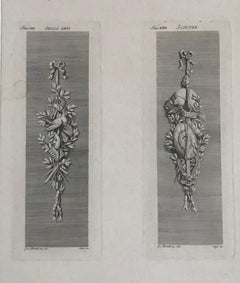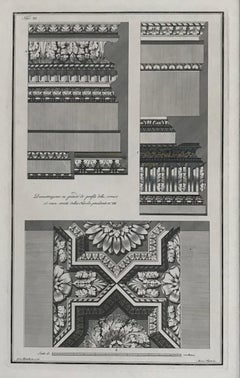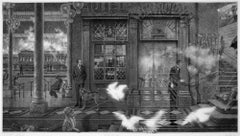Aldebaran Fine Art Interior Prints
to
4
Overall Width
to
Overall Height
to
4
4
4
4
2
2
1
1
1
1
1
1
4
4
Ceiling designs. A set of three architectural engravings.
By Albertolli Giacondo
Located in Paris, FR
Ceiling designs. A set of three architectural engravings.
These engravings are framed in white gold covered french frames.
From the publication publishe...
Category
1780s Interior Prints
Materials
Engraving
Chandelier designs. A pair of engravings
By Albertolli Giacondo
Located in Paris, FR
Chandelier designs. A pair of architectural engravings.
These engravings are framed in white gold covered french frames.
From the publication published in Milan in 1782.
"Different o...
Category
1780s Interior Prints
Materials
Engraving
Allegory of the four seasons. Four engravings on two framed sheets.
By Albertolli Giacondo
Located in Paris, FR
Allegory of the four seasons. A pair of engravings.
These engravings are framed in white gold covered french frames.
From the publication published in Milan in 1782.
"Different ornam...
Category
1780s Interior Prints
Materials
Engraving
Architectural designs. A set of nine architectural engravings.
By Albertolli Giacondo
Located in Paris, FR
Architectural designs. A set of nine architectural engravings.
These engravings are framed in white gold covered french frames.
From the publication published in Milan in 1782.
"Diff...
Category
1780s Interior Prints
Materials
Engraving
Related Items
Interiors VII: The Train from Munich
By Peter Milton
Located in Middletown, NY
Interiors VII: The Train from Munich
Robert E. Townsend, 1991.
Resist ground etching and engraving with hand refinement in charcoal, pencil, stabilo, and eraser on BFK Rives white wove paper, 20 x 36 inches (507 x 914 mm), full margins. Signed, titled, dated and numbered 51/175 by the artist in pencil, lower margin. A brilliant, inky impression with luminous light and gradient tones. In excellent condition with one extremely minor and superficial spot of light tan adhesive residue on the verso, unobtrusive and not visible on the recto, with no other visible defects. With the blind stamp of the printer, Robert E. Townsend in the lower left margin. An especially fine impression in superb condition. [Milton 113].
When asked about this work in particular, Milton expressed that his favorite images were his darkest images, in theme, mood, and in ink. Milton, who has said that his work is infused with a postmodern awareness of the past, has focused here in a deeply personal way on a segment of history that continues to haunt us all. The work, published in 1991, evokes one of the darkest periods of European history, the eroding and erasing of European culture under fascism, and the eventual total loss of humanity. The Train from Munich is an especially relevant and emotional work for Milton, who created the piece for his wife, Edith, who escaped Munich in 1939 as a child on the fabled Kinderstransport. The Kinderstransport was a desperate rescue effort on the part of the British government to save as many Jewish children as possible by railway before borders closed on the precipice of the Second World War. Children left their parents behind, and boarded the trains alone, leaving the impending doom of Nazi Germany, they arrived in Great Britain as refugees. More than 10,000 children escaped the holocaust via the Kinderstransport. In Train from Munich, the image itself holds an almost immeasurable amount of symbolism; each inch of the matrix is a successful effort to confront this history in a way that is poignant through a series of motifs. We see the Café disappearing into a ghostlike memory of the past, an allegory to the disintegration of culture, while through the windows we can see a rampant, snarling dog; a portrait of Hitler's shepherd, Blondi. Blondi isn't the only notable figure in the composition. Milton has pointed out that the fading figure of the doorman at the Hotel Metropole is modeled after the artist and intellectual Marcel Duchamp, and the face of the young girl peering...
Category
1990s American Modern Interior Prints
Materials
Charcoal, ABS, Engraving, Etching
Un Sculpteur de Paris
By Arthur William Heintzelman
Located in Middletown, NY
Etching and drypoint on cream laid Van Gelder Zonen watermarked paper, 8 7/8 x 6 1/2 inches (220 x 164 mm), full margins. Signed, titled, and inscribed "ed. 100" in pencil, lower mar...
Category
Early 20th Century Modern Interior Prints
Materials
Laid Paper, Drypoint, Etching
The Great Fire of London, 1666
By James Stow
Located in Middletown, NY
A rare early 19th century view of the Great Fire of London over Ludgate, enhanced with hand coloring.
London: Robert Wilkinson, 1811.
Copperplat...
Category
Early 19th Century English School Interior Prints
Materials
Handmade Paper, Engraving, Watercolor
Synagogue Duke's Palace Houndsditch by Th. Sunderland after Pugin & Rowlandson
By Thomas Rowlandson
Located in Middletown, NY
A faithful architectural rendering of the earliest Ashkenazi synagogue constructed in London; built about 1690, and subsequently destroyed in the Blitz, 1941.
London: Rudolph Ackerm...
Category
Early 19th Century English School Interior Prints
Materials
Handmade Paper, Engraving, Aquatint
$500
H 9.25 in W 11 in
Rococo design for a gate, German mid 18th century etching
By Joseph Baumann
Located in Melbourne, Victoria
Rococo design for a gate, etching, by Joseph Baumann (active 1740-1760), circa 1750.
Published by Martin Engelbrecht (1684–1756).
Similar works ar...
Category
Mid-18th Century Rococo Interior Prints
Materials
Engraving, Etching
$165
H 9.06 in W 14.57 in
Rococo interior design and furniture, German mid 18th century etching
By Franz Xaver Habermann
Located in Melbourne, Victoria
Rococo interior design and furniture, etching, by Franz Xaver Habermann (1721-1796), circa 1750.
Lettered 'F. X. Haberman, inv. et del. loh. Georg Hertel, excud : Aug. Vind., number...
Category
Mid-18th Century Rococo Interior Prints
Materials
Engraving, Etching
$165
H 9.06 in W 14.57 in
Les Belles et la Bête: Before the Hunt
By Peter Milton
Located in Middletown, NY
Resist ground etching and engraving on cream wove paper, 22 x 39 inches (558 x 990 mm), full margins. Signed, titled, dated, and numbered 27/160 in pencil, lower margin. With the blindstamp of the printer, Robert E. Townsend, in the lower left margin. A beautiful, richly inked impression of this highly detailed, large image. In very good condition with minor mat tone, extremely minor scattered light surface soiling, and one pin-point sized dot of brown discoloration on the lower left margin, recto, well outside of image area.
[Milton 99].
Milton states that there is a metaphorical evolution at the root of his body of graphic work, and with Les Belles et la Bête, Before the Hunt, he found himself at a crossroads that he viewed as a sort of artistic adolescence, which he felt demanded a natural examination of mysteries of sexual awakening. The image is brimming with fantastical images and metaphors for the confrontation of sexual exploration; a Freudian analyst appears in the left of the image, scattered tableaus of paired figures...
Category
1970s American Modern Interior Prints
Materials
Engraving, Archival Paper, Etching
Bidet Shaving and Night Tables, Hepplewhite Georgian furniture design engraving
Located in Melbourne, Victoria
'Bidet Shaving Table and Night Table'
From George Hepplewhite's 'Cabinet-Maker and Upholsterer's Guide', published by I. and J. Taylor in 1788. These en...
Category
Late 18th Century English School Interior Prints
Materials
Engraving
$90
H 9.06 in W 14.38 in
The Heidelberg Tun: A Framed 17th Century Engraving of a Huge Wine Cask
Located in Alamo, CA
"The Heidelberg Tun" is a 17th century engraving by an unknown artist. It depicts a famous huge ornamental wine cask that resided in the wine cellar of Heidelberg Castle. The cask shown here, built in 1664, is the second of four Heidelberg Tuns; the first was destroyed during the Thirty Years' War, between 1618 and 1648. This cask was built in 1664 when Karl Ludwig ordered Heidelberg cellar master...
Category
Late 17th Century Old Masters Interior Prints
Materials
Engraving
$1,575
H 22.94 in W 27.13 in D 1.25 in
A Scene in the New Farce —as performed at the Royalty Theater
By George Cruikshank
Located in Middletown, NY
A Scene in the New Farce —as performed at the Royalty Theater
London: George Humphrey, 1821.
Etching and engraving on cream wove paper with extensive hand coloring in watercolor. 9 5/8 x 13 3/4 inches (244 x 348 mm), trimmed at the platemark. A beautiful impression of this large, intricate print...
Category
Early 19th Century Figurative Prints
Materials
Watercolor, Engraving, Etching
$1,800
H 9.625 in W 13.75 in
Interiors I: Family Reunion — A penetrating scene with a hidden homage to Eadwea
By Peter Milton
Located in Middletown, NY
Interiors I: Family Reunion
1984
Resist ground etching and engraving on BFK Rives wove paper, 20 x 36 inches (501 x 913 mm), full margins. Signed, titled, dated and numbered 49/175 in pencil, lower margin. In excellent condition with minor mat tone. A luminous, rich, and well-inked impression of this haunting image, with astonishing detail and depth. Framed handsomely under museum grade glass with archival materials in a solid wood frame with silver finish. [Milton 107]
Intended to be a stand alone image in its inception, Family Reunion ended up spawning seven additional images, and became a sort of Primo Pensiero in the sprawling, masterpiece suite now known as Interiors. The suite took eight years to complete, and consists of works of varying format, psychological intensity, and subject matter. The thematic darkness in the eight images waxes and wanes, and Milton intentionally included several interlude works to lighten the tension he felt while composing several of the darker images. The first two in the series, Family Reunion, and Hotel Paradise Café, were meant to be companion pieces. The equilibrium of each composition is anchored on a central brooding figure; a man (perhaps based on a Thomas Eakins portrait of the American anthropologist Frank Hamilton...
Category
1980s American Modern Figurative Prints
Materials
Etching, Engraving
Les Belles et La Bête I: The Rehearsal
By Peter Milton
Located in Middletown, NY
Resist ground etching and engraving on Rives heavyweight buff paper, 20 x 36 inches (508 x 914 mm), full margins. Signed, titled, dated and numbered 103/160 in pencil, lower margin. Minor mat tone. A rich and finely printed impression of this complex and iconic work by Milton. Framed handsomely under Plexiglas with archival materials in a solid wood frame with silver finish.
[Milton 98].
Milton states that in the evolution of his body of graphic work he found himself at point that necessitated the exertion of nerve in his subject matter. He found it imperative for growth to explore whether his compositions had previously been too polite, and through this process he experienced a great burst of artistic and psychic liberation. Milton refers to this awakening as a sort of adolescence, which he felt demanded a natural examination of mysteries of sexual awakening. Les Belles et La Bête...
Category
1970s American Modern Interior Prints
Materials
Engraving, Archival Paper, Etching
